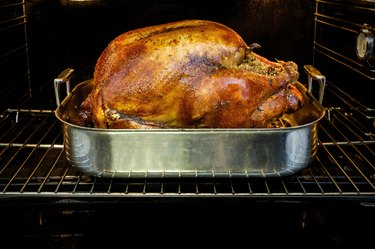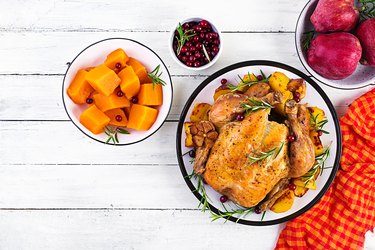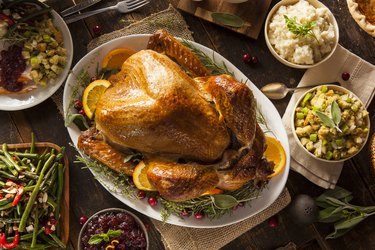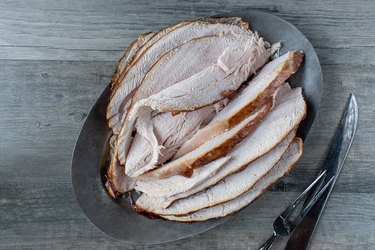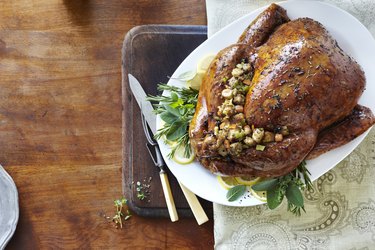
Should you cover turkey with foil while it cooks? Well, putting aluminum foil over turkey can help the cooking process as it roasts.
There are two ways to do it: Encase the turkey in the foil before roasting it in a hot oven or use the foil as a tent to control the level of browning.
Video of the Day
Video of the Day
Covering the whole turkey with foil is a popular cooking method because it steams the turkey in its own juices, per the University of Illinois Extension (UIE). If done correctly, the end result is a wonderfully moist bird with golden brown, non-crispy skin.
When deciding whether to cover your turkey with foil or not, consider that enclosing it makes it cook faster. The compromise here is that the turkey skin, while golden, won't come out crispy.
If you're looking for a crispier result, you should tent your turkey with aluminum foil. The tent method yields perfectly brown, crispy skin and a slow-roasted flavor, but it does takes more time.
Tip
Don't stuff your turkey before cooking it, especially if it is enclosed in a small space, per the USDA. So, if you are fully enclosing your bird in foil, or you are grilling, microwaving or deep-frying it, don't stuff your turkey.
The faster cooking times don't allow the stuffing to heat quickly enough to kill foodborne bacteria in the stuffing. If you are tenting the turkey, you can stuff it, but it's still safer to cook stuffing separately, per the UIE.
How to Cook a Turkey With Aluminum Foil
To cover or not to cover a turkey? If you have a limited amount of time to roast your bird, you can cover turkey in aluminum foil beforehand, which will shorten the cooking time. Just make sure you don't seal the foil so it's airtight, or moisture will be trapped inside and affect the end result.
- Preheat the oven to 450 degrees Fahrenheit, according to the UIE.
- Tear off a piece of 18-inch-wide, heavy-duty aluminum foil that is three times longer than the length of the turkey. Lay it over a large roasting pan, centered lengthwise.
- Place the turkey on the aluminum foil breast-side up. Brush the turkey with melted butter or vegetable oil.
- Bring the sides of the aluminum foil up along the sides of the turkey. Bring the ends of the foil up over the top of the turkey. Overlap the ends of the foil so they will stay in place, but don't seal them so they are airtight.
- Put the turkey in the oven. Roast the turkey until a meat thermometer inserted into the thickest part of the thigh reads a minimum of 165 Fahrenheit, according to the UIE.
The cooking time for a turkey wrapped in foil will vary based on the weight of your bird. An 8- to 12-pound turkey will need 2.75 to 3 hours to cook through at 325 F, according to the USDA Food Safety and Inspection Service. Roasting at a higher temperature lowers this cooking time.
At What Temperature Should You Cook Your Turkey?
Your oven temperature should be set at no lower than 325 F, according to the USDA. A higher temperature will speed up the cooking time.
When it comes to foil-wrapped turkey, you can set your oven at a higher temperature — the UIE suggests 450 F.
A whole turkey is safe to eat when its internal temperature is a minimum of 165 F, which can be measured with a food thermometer.
Foil Tent Turkey Cooking Instructions
- Preheat the oven to 325 degrees Fahrenheit.
- Place the turkey in the roasting pan breast-side up.
- Brush the turkey with melted butter or olive oil.
- Here's how to tent with foil: Make a tent-shape with the foil by creasing a piece of foil in the center. Prop it up over the turkey. The ends will be in the roasting pan. Stand the center up 1 inch over the turkey breast to allow for air flow.
- Put the turkey in the oven. Roast it until a thermometer inserted in the innermost part of the thigh and wing and the thickest part of the breast reaches 165 degrees Fahrenheit, per the UIE. Let the turkey stand for 20 minutes, per the USDA, to make it easier to carve.
Other Tips for Roasting Your Turkey With Foil
Foil-covered turkey won't brown well if it's covered for the entirety of its cooking time. You have some options to ensure the bird is cooked to perfection.
- Begin cooking your bird without the aluminum foil for the first two-thirds of the time. This is when you will leave the turkey uncovered for browning. At the two-thirds point, lay a piece of foil loosely over the turkey to keep the breast from browning further while the thigh meat continues to heat to the desired temperature.
- If your turkey is looking a little pale for your taste, remove or fold back the foil for the last 30 minutes of roasting. You can brush the skin with some vegetable oil to enhance the browning process, per the UIE.
- No matter which method you're using, don't cover the turkey with foil after you remove it from the oven because this can continue to cook the bird, which will dry it out.
- To season your turkey, place fresh herbs, onions, garlic or peppers in the cavity before roasting it.
- University of Illinois Extension: "Turkey for the Holidays - Foil Wrapped Method"
- University of Illinois Extension: "Traditional Roast Turkey (Unstuffed)"
- American Heart Association: "Saturated Fats"
- USDA: "Turkey Basics: Stuffing"
- USDA: "Let's Talk Turkey—A Consumer Guide to Safely Roasting a Turkey"
